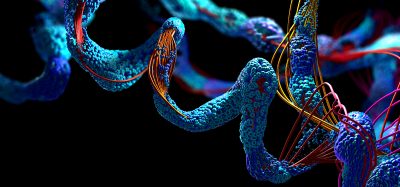New technique enables in vivo analysis of protein complexes
Posted: 11 May 2023 | Izzy Wood (Drug Target Review) | No comments yet
Chinese researchers use a glycosidic-bond-based mass-spectrometry-cleavable cross-linker to analyse proteins in vivo.


A research team from the Dalian Institute of Chemical Physics (DICP) of the Chinese Academy of Sciences (CAS), China, has developed a glycosidic-bond-based mass-spectrometry-cleavable cross-linker, which improves the data analysis throughput and identification accuracy of cross-linking information with good amphiphilicity and biocompatibility. It enables in vivo cross-linking of protein complexes in live cells and achieves large-scale and precise analysis.
As the executor of life activities, proteins exert their specific biological functions through interactions such as forming protein complexes. The localisation effects, crowding effects, and organelle micro-environments within cells are crucial for maintaining the structure and function of protein complexes. This study was published in Angewandte Chemie International Edition.
Chemical cross-linking mass spectrometry (CXMS), especially in vivo CXMS, is a large-scale analysis of in-situ conformation and interaction interface of protein complexes in living cells. However, in vivo CXMS in living cells faces challenges such as high cell disturbance and complex spectra retrieval of cross-linked peptides.
In this study, the researchers incorporated glycosidic bonds into the design of functional cross-linkers based on the high biocompatibility of glucose molecules and the mass spectrometry cleavable feature of glycosidic bonds. They screened and obtained trehalose, a highly biocompatible molecule, as the skeleton molecule and developed a mass spectrometry cleavable cross-linker, trehalose disuccinimidyl succinate (TDS).
This cross-linker showed superior cell viability maintenance compared to currently reported membrane-permeable chemical cross-linkers and enabled efficient cross-linking of protein complexes in cells under low disturbance conditions.
Researchers develop Raman imaging probes for detecting enzyme activities
The researchers found that low-energy glycosidic bond–high-energy peptide bond mass spectrometry selective fragmentation mode reduced analysis complexity of the cross-linked peptide fragment spectra, significantly improving the efficiency and accuracy of cross-linked peptide identification.
They identified conformation of 1,453 proteins corresponding to over 3,500 cross-linked peptide pairs, and 843 protein-protein interaction information from Hela cells.
“We have accurately realised in-vivo cross-linking and global analysis of protein complexes in live cells, and provided an important toolkit for exploring the interaction sites of protein function regulation in live cell microenvironment,” concluded Professor Zhang Lihua from the Dalian Institute of Chemical Physics (DICP) of the Chinese Academy of Sciences (CAS).
Related topics
Imaging, Mass Spectrometry, Protein, Proteomics
Related organisations
Dalian Institute of Chemical Physics (DICP) of the Chinese Academy of Sciences (CAS)
Related people
Professor Zhang Lihua








